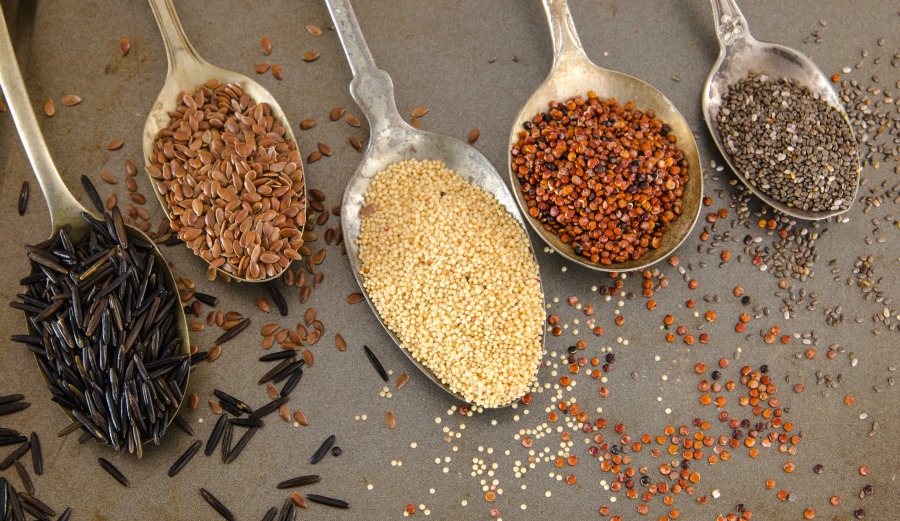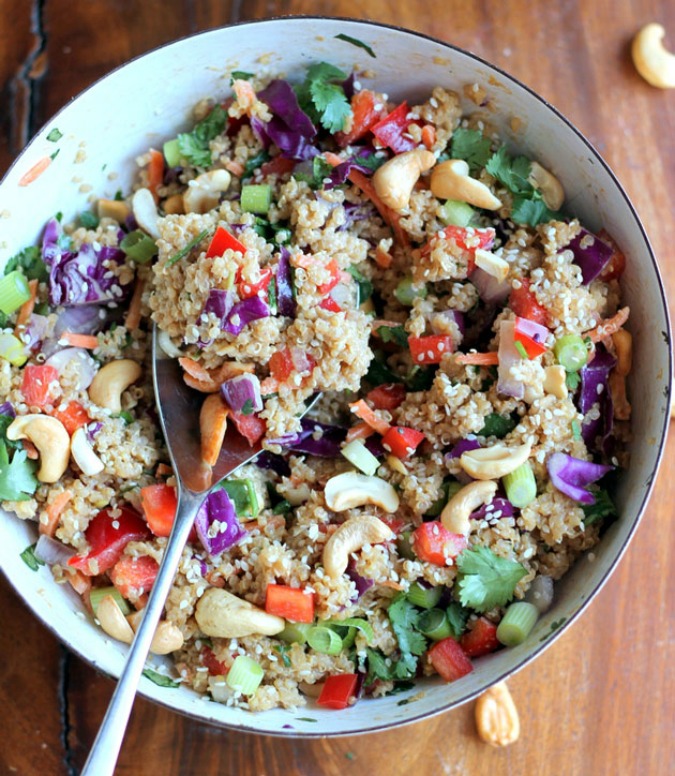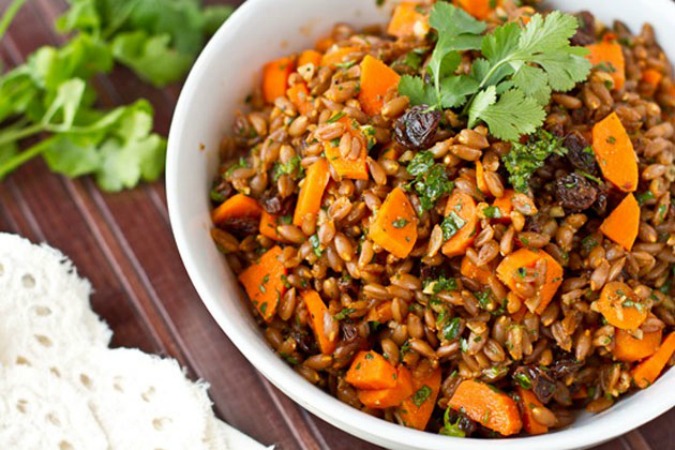
The good folks at Everup bring you Super Grains Explained. Photo: Shutterstock.
You’ve been hearing smatterings about these “trendy” ancient grains for awhile now—so you decide to see what all of the fuss is about. But when you get to Trader Joe’s and see the real estate they’ve managed to secure, the feeling that comes over you is nothing short of grain-induced panic.
What are all of these things? What is the difference between them? How would you even begin to build a meal around one of them (that wouldn’t take up precious hours of your lazy Sunday)? Paralyzed in your tracks, taking in the wide expanse of options, you feel the anxiety sweats coming on—so you grab a box of brown rice and head for the checkout line as fast as humanly possible without looking like you’ve planted a bomb in the grain aisle.
But the halo of confusion surrounding ancient grains is really unnecessary; as the name implies, they are nothing new. While some of them may be a recent addition to the menu of the farm-to-table restaurant in your neighborhood, they’ve been on people’s tables for centuries.
They are nothing to be intimidated by.
If you can cook pasta, you can prepare any of the grains taunting you from the shelf—boil water, add grain, watch them cook—and with a slight adjustment in cooking time, they can be subbed in for rice in pretty much any recipe. So if you go in for millet and grab farro instead, it’s not the end of the world.
And the health nuts are on to something: there are some definite perks of incorporating them into your diet. Not only will experimenting with different grains keep meals interesting, and in turn satisfying (preventing cravings), but they also offer up pretty impressive nutritional profiles, including a hefty dose of fiber and protein, satiating nutrients that aid in weight loss and maintenance and help keep mood and energy levels stable. So the next time you host a dinner party, add a super-grain to the spread and await the praise and admiration of your guests (no one has to know the extent of your effort was lifting your glass to sip your Cabernet while you watched the grain cook).
It’s time to expand your culinary horizons (sorry Minute Rice). Add one of these trendy super grains to your shopping cart this week:
Freekeh (pronounced free-kah)
Alternate Names: Freekah, Frikeh, Farik, Fireek
Common in Mediterranean and Middle Eastern cuisine, the grain is made from wheat that is harvested early (when it’s still green) and toasted, dried and rubbed. The resulting flavor is nutty, with a chewy texture. The grain has three times the fiber of brown rice, and more protein and fiber than quinoa. You may see whole and cracked freekeh on shelves—the only difference is that the cracked version has been broken into smaller pieces, which will shorten cooking time.

Quinoa salad.
Quinoa (pronounced keen-wah)
Once a food ordered only at uber-trendy restaurants by green-juice sipping yogis, quinoa has become one of the most recognizable super grains. But what many people don’t know is that while quinoa is a grain crop, the part we eat is actually a seed (that we cook and serve like a grain). It’s a great plant-based source of complete protein (meaning it contains all of the essential amino acids), with 8 grams of protein per cup. It can be swapped in for rice in any recipe, adding a unique texture and boost of nutrients like iron, potassium, fiber and B vitamins.
Try It In: Crunchy Cashew Thai Quinoa Salad with Ginger Peanut Dressing
Kamut (pronounced kah-moot)
Alternate Names: Khorasan
Kamut is the trademarked brand name for Khorasan wheat. The large kernels have a buttery flavor and hold their shape well, so you can toss it into soups and stews and not have to worry about it turning into a slop reminiscent of elementary school hot lunch. A study published in the European Journal of Clinical Nutrition found that consuming Kamut led to a significant reduction of metabolic risk factors like total cholesterol and blood glucose. One cup provides over 100 percent of the daily recommended value of manganese—a nutrient that supports the nervous system, aids in metabolism, and regulates blood sugar—as well as dietary fiber, protein and minerals like selenium, zinc, and magnesium.
Try It In: Kamut, Kale & Cabbage Soup with Winter Pistou

Teff porridge.
Teff
Alternate Names: Tef, T’ef
Even though you’ve never tried it, this super small grain (about the size of a poppy seed) has been a staple in Ethiopian cuisine for centuries. It’s naturally gluten free, so you may see it ground into a flour and used in gluten-free baked goods. And the grain is quickly gaining traction among the health food community because of it’s nutritional profile, which boasts a solid amount of protein, iron and calcium. On shelves you may see it in a variety of different colors, from white to red to black—don’t get overwhelmed. All you need to know is: the lighter in color, the milder the flavor. The darker colored Tef has an earthier flavor. Its tiny size makes it a great base for polenta, hot breakfast cereal, and pilaf.
Try It In: Banana Almond Teff Porridge
Farro (pronounced FAHR-oh)
Alternate Names: Emmer Wheat
There is some confusion around this grain, so let us clarify: the term farro is “commonly used when referring to three ancient wheat varieties first cultivated in the Fertile Crescent and still grown in Italy: farro piccolo (also known by the German einkorn), farro medio (also known as emmer), and farro grande (also known as spelt),” wrote Maria Speck in Ancient Grains for Modern Meals. But in the United States we are usually talking about the emmer variety, which is most likely semi-pearled, a process that removes some of the bran (and subsequently some of the nutrients), but shortens cooking time significantly. Farro is high in fiber, protein and iron, and has a rich, nutty flavor and softer texture that makes it great for risotto-style dishes, but it also works well in soup and salad and as a simple side dish.
Try It In: Winter Fruit, Yogurt & Farro Parfaits

Spelt salad.
Spelt
Alternate Names: Dinkel Wheat, Hulled Wheat, Farro Grande
A European cereal grain that in prior years has most commonly showed up in flour form in baked goods, spelt is slowly rising in popularity. This is due in part to it being favored by the organic, health-conscious crowd since it requires less fertilizer and is naturally more resistant to disease and pests than other forms of wheat. Spelt also contains less gluten than wheat so it’s more easily digested by those with sensitivities. It’s sometimes mistaken for farro, and vice versa, but the two are actually different grains. While similar, spelt typically has a more al dente quality that works well in grain salads (now you can drop some knowledge in the grocery store).
Try It In: Carrot Raisin Spelt Berry Salad with Cumin and Cilantro
Amaranth (pronounced AM-ah-ranth)
Like quinoa, amaranth is a seed and a complete protein—and it’s naturally gluten-free. The greens of the plant have a slightly sweet flavor and can be used in cooking and in salads, while the seed is a popular ingredient in baked goods like breads, muffins and pancakes. With more protein than most other grains (nine grams per cup), it’s also the only grain that contains vitamin C, plus a high amount of calcium, iron, magnesium, phosphorus and potassium. Studies showed that those with cardiovascular disease who included amaranth in their diets saw a significant decrease in their total cholesterol, triglycerides and LDL (bad) cholesterol. Unlike other grains it never completely loses its crunch, so while the inside will soften when cooked, the outside retains it’s crunchy texture (described as a popping session when you bite into it), adding an interesting texture to salads and soups.
Try It In: Amaranth Patties

Sorghum white bean salad.
Sorghum (pronounced SOR-guhm)
Alternate Names: Milo
This grain is the latest on the radar of healthy foodies. But while it’s just starting to gain momentum in America (where now it is mostly used for animal feed), it’s the third largest food grain in the world, being used to make cous-cous, tortillas, flatbread and boiled like rice. The gluten-free grain doesn’t have an inedible hull like some other grains and is eaten with all its outer layers, so it’s a heartier grain that retains the majority of its nutrients. Sorghum is neutral in flavor with a hint of sweetness—you may see this sweetness put to use in baked goods and at your local coffee shop. That container of syrup between the half and half and the sugar packets is actually sorghum syrup, which comes from squeezing the juice from the stalks of the cereal grain and boiling it until thick and golden.
Try It In: Sorghum, Sweet Potato & White Bean Salad with Kale Pesto
Millet (pronounced MIHL-leht)
This grain is especially high in magnesium, and has a bland flavor that lends itself well to dishes with rich seasonings. In the U.S., millet is familiar to many as the main component of birdseed, but in other areas of the world it’s a diet staple (in India, it’s used to make roti, a flat bread, and in Africa it’s eaten as a porridge). It also works well in pilafs, soups or stews, and bread.
Try It In: Millet Cauliflower Mash
Your Secret Weapon at the Dessert Table
Ancient grains (and whole grains in general) are higher in fiber and protein than their refined counterparts, making them a smart way to make dishes more filling, while stabilizing blood sugars. In flour form they are a sneaky way to take dessert recipes lower on the glycemic index scale so that the sweets don’t have as large of an effect on your blood sugar levels—preventing dips and spikes that lead to moodiness and fatigue. You can buy each grain in flour form, or simply grind them in a blender until you reach a powder consistency.
Add these desserts with a super-grain boost to your recipe box:
Freekelicious Pumpkin & Chocolate Scones
Healthier Baked Cinnamon Spelt Doughnuts
Gluten-Free Strawberry Rhubarb Crisp
This content was originally created for EverUp. For more health content like this, click here.

